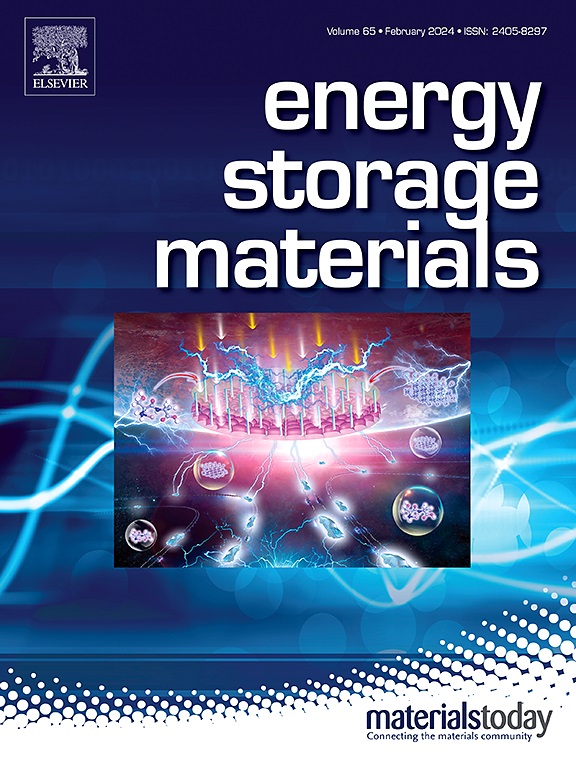将双离子存储和D-A效应集成到对称全有机钠电池的富氮聚合物中
IF 20.2
1区 材料科学
Q1 CHEMISTRY, PHYSICAL
引用次数: 0
摘要
有机钠离子电池因其低成本和对环境无害的特点而成为一个吸引人的主题。然而,有机分子有限的活性位点、相对较低的电压和较差的导电性阻碍了高能量和高功率密度的同时实现。本文设计并合成了一种具有 D-A 特性的双极聚合物,它由 n 型六氮杂萘(HATN)和 p 型 5,10-二氢吩嗪(PZ)组成,前者用于储存 Na+,后者用于储存阴离子。p 型 PZ 的工作电位升高以及 D-A 效应导致的电子转移增强是实现高功率密度的关键。具体来说,PZ-HATN 阴极在 0.2 A g -1 时可提供 235 mAh g-1 的高放电容量,在 10 A g-1 时可提供 157 mAh g-1 的放电容量,从而实现了 20.4 kW kg -1 的超高功率密度和 409.0 Wh kg-1 的高能量密度(在 10 A g-1 时,相当于 42C)。此外,PZ-HATN 的双极性确保了 2.1 V 的巨大电位差,从而促进了对称全有机电池(SAOB)的构建。这种 SAOB 具有高倍率能力和出色的循环稳定性(在 1 A g-1 条件下循环 10000 次后,持续放电容量为 96.8 mAh g-1)。这项研究有助于深入了解有机电极材料的结构-性能关系,对开发高性能全有机钠离子电池具有启发意义。本文章由计算机程序翻译,如有差异,请以英文原文为准。


Integrating dual-ion storage and D-A effect into a nitrogen-rich polymer for symmetric all-organic sodium batteries
Organic sodium-ion battery has emerged as an appealing theme due to its low-cost and environmentally benign features. However, the limited active sites, relatively low voltage, and poor conductivity of organic molecules hinder the simultaneous achievement of high energy and high power densities. Herein, a bipolar polymer with D-A character consisting of both n-type Hexaazatrinaphthalene (HATN) for Na+ storage, and p-type 5,10-dihydrophenazine(PZ) for anion storage is designed and synthesized. The elevated working potential from p-type PZ and enhanced electron transfer due to the D-A effect are crucial for achieving high power density. Specifically, the PZ-HATN cathode delivers a high discharge capacity of 235 mAh g-1 at 0.2 A g -1 and 157 mAh g-1 at 10 A g-1, leading to an ultrahigh power density of 20.4 kW kg -1 and a competitive energy density of 409.0 Wh kg-1(at 10 A g-1, corresponding to 42C). Furthermore, the bipolar nature of PZ-HATN ensures a substantial potential disparity of 2.1 V, facilitating the symmetric all-organic battery (SAOB) construction. The SAOBs exhibit high-rate capability and outstanding cycling stability (with a sustained discharge capacity of 96.8 mAh g-1 after 10,000 cycles at 1 A g-1). This study offers insights into the structure-property relationships of organic electrode material, and will be inspiring to the development of high-performance all-organic sodium-ion batteries.
求助全文
通过发布文献求助,成功后即可免费获取论文全文。
去求助
来源期刊

Energy Storage Materials
Materials Science-General Materials Science
CiteScore
33.00
自引率
5.90%
发文量
652
审稿时长
27 days
期刊介绍:
Energy Storage Materials is a global interdisciplinary journal dedicated to sharing scientific and technological advancements in materials and devices for advanced energy storage and related energy conversion, such as in metal-O2 batteries. The journal features comprehensive research articles, including full papers and short communications, as well as authoritative feature articles and reviews by leading experts in the field.
Energy Storage Materials covers a wide range of topics, including the synthesis, fabrication, structure, properties, performance, and technological applications of energy storage materials. Additionally, the journal explores strategies, policies, and developments in the field of energy storage materials and devices for sustainable energy.
Published papers are selected based on their scientific and technological significance, their ability to provide valuable new knowledge, and their relevance to the international research community.
 求助内容:
求助内容: 应助结果提醒方式:
应助结果提醒方式:


